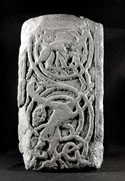Select a site alphabetically from the choices shown in the box below. Alternatively, browse sculptural examples using the Forward/Back buttons.
Chapters for this volume, along with copies of original in-text images, are available here.
Object type: Part of cross-shaft
Measurements: H. 68.8 cm (27 in); W. 38 > 36.3 cm (15 > 14.3 in); D. 19 cm (7.5 in)
Stone type: Medium- to coarse-grained grit, burnt light red (2.5 YR 6/8); see no. 1.
Plate numbers in printed volume: 369-372
Corpus volume reference: Vol 3 p. 109-110
(There may be more views or larger images available for this item. Click on the thumbnail image to view.)
The fragment is from the top of a cross-shaft, as the dowel hole in face E testifies.
A (broad): The edge moulding is double and flat. It flanks a single panel containing an inhabited scroll. The scroll is of a large open spiral type, without leaves. The stem is finely modelled. Two registers survive; the lower scroll terminates in a rosette berry bunch and forms asymmetrical loops lower down towards the fracture. The registers are joined by a lightly ridged node.
Through the scrolls leap two large quadrupeds. They share the same form: triangular chests; long slender legs; long stretching necks; and pear shaped thighs. The ears drop and the open jaws have fangs. They dominate their scrolls, their legs interlacing with the spiral scroll in an 'Anglian lock'. The lower beast leaps diagonally upwards; the upper one is passant and looks backwards. The tails loop around the scroll stems.
B (narrow): The edge moulding is double and flat. The panel contains a looping strand in 'knitting stitch'. The strand is modelled.
C (broad): The double, flat edge moulding flanks a panel containing four pairs of linked plant-scrolls each terminating in a rosette berry bunch. The scrolls are linked vertically and horizontally by plain nodes with protruding pointed leaves. The cutting is in high relief.
D (narrow): The double edge moulding is flat. The panel contains a changing interlace pattern, the component units separated by short glides. At the top is a unit of half pattern F, the loop facing right, then a unit of half pattern C with outside strand, and below that, two units of half pattern F with the loops facing left. The pattern of the next unit is unclear as it is partly broken away; it may have been another unit of half pattern C, turned another way.
E (top): There is a dowel hole in the top of the shaft.
In terms of the Anglian tradition, this piece is indeed degenerate (Cramp and Lang 1977, no. 9), for the plant-scrolls have turned into geometry and lost much of their foliate appearance. The trend can be seen on the shaft from Croft, North Riding (Collingwood 1907, 306, figs. a–d on 307), where the same use of interlace on the narrow faces is observable. The dropped loops of the 'knitting stitch' are found on Leven 1 (Ill. 628), another ninth-century piece. The scroll on Face C, however, has a very close parallel in Jarrow 1A, co. Durham (Cramp 1984, I, 106–7, II pl. 90, 474), dated to the late eighth century.
The animals dominate face A. The threading of their limbs through the scroll is an exaggeration of the 'Anglian lock' of earlier Northumbrian pieces, but here the grace and movement of the beast contrast with the static, star-like creatures of Croft, and St Andrew Auckland, co. Durham (Cramp and Lang 1977, no. 3; Cramp 1984, II, pl. 5, 14) The long necks and legs derive from the Anglian 'Great Beast' which is common in the ninth-century in Yorkshire and Mercia (Cramp 1978, figs. 1.1, 1.2), yet the head shape and their prominence over the foliage point the way forward to Anglo-Scandinavian fashions. This may be the local origin of the tenth-century beast-chains, and already, before the Viking incursion, the new taste for animal ornament is beginning to prevail. Collingwood's view has been corroborated by later finds in York.



